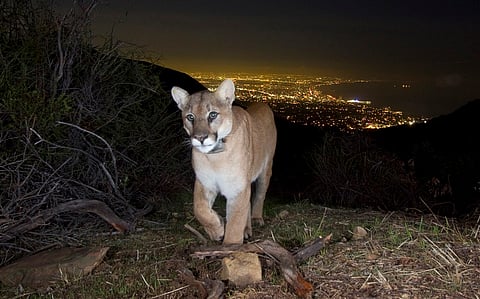Mountain lion kittens would have certainly perished in LA wildfires: Sanjay Gubbi
The wildfires in Los Angeles, the second-largest city in the United States, have been estimated to be the costliest such disaster in US history.
The fires have destroyed a large part of the metropolitan area of Los Angeles. And while conversations have whirled around the role of human-induced climate change and the human death toll, the toll on the wildlife of the mega polis has not yet been highlighted.
Los Angeles, or LA, is unique in that as a mega polis, it hosts a mega carnivore, the puma (Puma concolor). The cougar, known by a bevy of names including puma, mountain lion and panther, is one of the two great cats of the Americas, the other being the jaguar. Pumas are found across the length of the American continent — from Yukon in Arctic Canada to the Patagonian Andes in South America.
The mountain lions of LA have often been the subject of fascination. But so far, the impact of the wildfires in LA on these unique big cats has largely been absent from the media.
Down To Earth spoke to Sanjay Gubbi, conservation biologist and expert on leopards, about the mountain lions of LA in the aftermath of the LA wildfires. Excerpts from the conversation:
Rajat Ghai (RG): What would have been the likely impact of the wildfires in LA on its mountain lions?
Sanjay Gubbi (SG): While adult mountain lions are generally capable of escaping wildfires due to their agility and ability to flee, the situation is far more dire for their young. Mountain lion kittens, often hidden in tree trunks, small dens, or other secluded spaces, are highly vulnerable. Tragically, these hiding places make them susceptible to smoke inhalation and burns. Very young kittens, unable to escape, are likely to perish in such circumstances, leading to a significant loss of individuals in wildfire-affected areas.
The long-term implications of such losses are profound. A decline in the number of kittens can hinder the population’s ability to recover over time, potentially reducing genetic diversity and destabilising local ecosystems.
Additionally, the fires devastate the habitat and food sources of the mountain lion’s prey. With large areas of vegetation destroyed, the recovery of prey populations will likely take time. If the prey recovery is prolonged it could have a cascading effect, placing further pressure on mountain lion populations as they struggle to find sufficient resources in the post-wildfire landscape.
Research conducted in the United States also highlights another critical consequence of wildfires: mountain lions tend to avoid areas affected by fires. Post-wildfire behavior changes include increased road crossings and heightened daytime activity—both of which elevate risks for these animals.
These behavioural shifts can result in a higher likelihood of vehicular collisions and escalate the potential for human-mountain lion conflicts. Such interactions not only threaten mountain lion survival but also pose challenges to public safety and wildlife management efforts.
RG: What can the scientific community do to keep a tab on this unique population of big cats whenever such disasters strike?
SG: Wildlife management and weather prediction systems in the United States are far more advanced compared to many other regions. Sophisticated scientific tools are employed to predict, monitor, and manage forest fires effectively.
However, climate change—characterised by hotter, drier conditions, erratic precipitation, and weather extremes—has likely exacerbated the severity of wildfires, such as those witnessed in Los Angeles. These factors underscore the urgent need to address and mitigate the impacts of climate change before they lead to more devastating outcomes.
While science forms a critical foundation for conservation efforts, it is equally important for society and policymakers to translate scientific insights into action. The collaboration between scientific research, public engagement, and effective policy implementation is key to mitigating the effects of climate change and preventing catastrophic events like the LA fires.
RG: What lessons does this have for other cities in the world which host mega carnivores in their periphery or midst like Mumbai’s leopards and Bengaluru’s tigers?
SG: As urbanisation accelerates and cities expand, wild landscapes are increasingly being encroached upon. To mitigate the impact of this expansion, it is crucial for governments to establish and maintain buffers between urban areas and natural ecosystems. Without such buffers, there is a heightened risk of incidents like the Los Angeles wildfires, where wildfires encroach upon and consume human settlements.
A positive example can be seen in Bengaluru, where some areas have a buffer between the city and Bannerghatta National Park. These deciduous forests, under both government and private control, act as a protective barrier and serve as vital ecosystems. It is imperative that such buffers are preserved and managed effectively.
By maintaining these green zones, we can significantly reduce the risk of human-wildlife conflicts and prevent disasters like wildfires from threatening human habitations. Protecting these natural spaces is not just an environmental necessity but also a critical measure for safeguarding communities.


